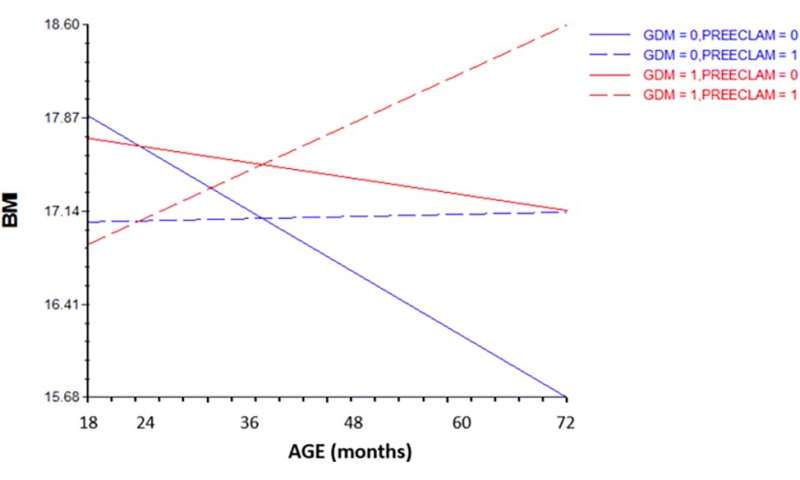Kids born to moms with gestational diabetes and preeclampsia at greater risk for obesity


Childhood obesity is a growing problem in the United States. For children, obesity is defined as having a body mass index (BMI) at or above the 95th percentile, and according to the Centers for Disease Control and Prevention, 18.5% of children between the ages of 2 and 19 meet this criteria.
Diet, exercise, and genetics are familiar risk factors in childhood obesity. Prenatal origins also play a role, yet they are underexplored, said Yonglin Melissa Huang, a Ph.D. student at The Graduate Center, CUNY and lead author of a new study that shows a link between multiple metabolic disorders in pregnant women and their children’s BMI later in life.
The study, which appears in Archives of Gynecology and Obstetrics and comes from the lab of Graduate Center, CUNY and Queens College Psychology Professor Yoko Nomura, asked how pregnancy conditions can play a role in childhood obesity. The researchers found that when a mother experiences both gestational diabetes and preeclampsia, the child has a growth trajectory that leads to an increased risk of high childhood BMI over time.
“Prospective parents may benefit from our findings by better understanding the effects of gestational diabetes and preeclampsia on their child,” Huang said. “These findings can provide added incentive for pregnant women and their health care providers to work closely to manage and treat these conditions during pregnancy so they can address both the mother’s safety and the child’s long-term health.”
The study results should also encourage health care providers to coordinate care of mothers and children who experience these dual conditions over a longer period of time following birth, said researchers.
“OB-GYNs have experience in managing gestational diabetes and preeclampsia but they do not provide care to the children or help reduce their obesity risk,” said Nomura. “Coordinating between obstetricians, endocrinologists, and pediatricians could help prevent childhood obesity.”

When a pregnant woman has gestational diabetes, a hormone produced by the placenta stops the body from effectively using insulin, causing blood sugar to rise. Preeclampsia is a more serious and potentially life-threatening complication in which the mother experiences high blood pressure and often damage to the kidneys or liver.
Nomura and her group have previously studied the associations of gestational diabetes and preeclampsia, independently, with children’s BMI. In the new study, the team collaborated with Daniel W. Skupsky, M.D., chair of the Obstetrics and Gynecology Department at New York Presbyterian Queens, and explored what happens when a pregnant mother has both conditions at once since those two illness are relatively common and often comorbid. The team monitored the children of 356 mothers from 18 to 72 months.
The results showed that the combination of both gestational diabetes and preeclampsia during pregnancy was especially effective in driving high BMI during early childhood—more so than either condition alone. Confirming previous findings, the researchers also saw that children born from mothers with only one of these conditions are also at risk for a higher BMI, though the trend for gestational diabetes was not as strong.
Source: Read Full Article